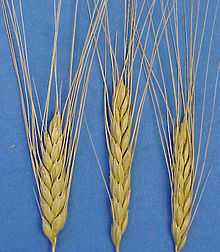Farro

Farro is a food product composed of the grains of certain wheat species in whole form. The exact definition is debated. It is sold dried and is prepared by cooking in water until soft, but still crunchy (many recommend first soaking overnight). It may be eaten plain, though it is often used as an ingredient in dishes such as salads and soups. It is sometimes ground into flour and used to make pasta or bread.
Definition
There is some confusion as to what farro is. Einkorn (Triticum monococcum), emmer (Triticum dicoccum), and spelt (Triticum spelta) are called farro in Italy, sometimes (but not always) distinguished as farro medio, farro grande, and farro piccolo, respectively.[2] Emmer grown in the Garfagnana region of Tuscany is known as farro, and can receive an IGP designation (Indicazione Geografica Protetta), which by law guarantees its geographic origin.[2] Emmer is by far the most common variety grown in Italy, in certain mountain regions of Tuscany and Abruzzo. It is also considered to be of a higher quality for cooking than the other two grains and is sometimes called "true" farro.[3]
Regional differences in what is grown locally and eaten as farro, as well as similarities between the three grains, may explain the confusion. Barley and farro may be used interchangeably because of their similar characteristics. Spelt is much more commonly grown in Germany and Switzerland and is eaten and used in much the same way, and might therefore be considered faro, as is épeautre (Triticum spelta), in France (where, like for faro in Italy, there is "petit", "moyen" and "grand" épeautre. Common wheat (Triticum aestivum) may also be prepared and eaten much like farro, in which form it is often referred to as wheatberries.
The emmer variety of farro is often confused with spelt, though it is an entirely different species.[4]
Etymology
The Italian word farro is derived from the presumed Vulgar Latin word farrum, from Standard Latin far, farris n. : 'a kind of wheat' (as in farina (food)). Far in turn is derived from the Indo-European root *bʰar-es- : 'spelt', which also gave rise to the English word barley, Albanian bar : 'grass', Old Church Slavonic брашьно (brašĭno) : 'flour', and Greek Φήρον (Phḗron): 'plant deity'.
Sizes
The three species are sometimes known as farro piccolo, farro medio, and farro grande, which are einkorn, emmer, and spelt, respectively.[2] While these names reflect the general size difference between these three grains, there are landraces of each that are smaller or larger than the typical size and cross into the size range of the others.
References
- ↑ Suzanne Hamlin (June 11, 1997). "Farro, Italy's Rustic Staple: The Little Grain That Could". The New York Times.
- ↑ 2.0 2.1 2.2 Markus Buerli (2006). "Farro in Italy: A desk study". The Global Facilitation Unit for Underutilized Species.
- ↑ Hamlin, Suzanne (June 11, 1997). "Farro, Italy's Rustic Staple: The Little Grain That Could". New York Times. Retrieved November 22, 2012.
- ↑ http://www.nytimes.com/2008/11/30/magazine/30food-t-000.html?_r=0